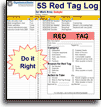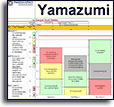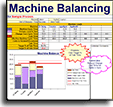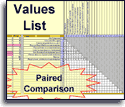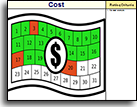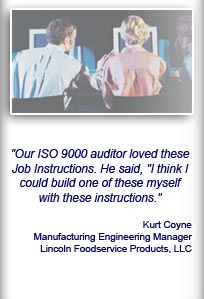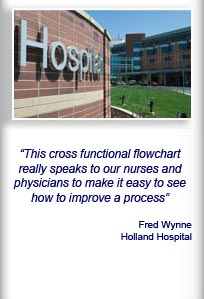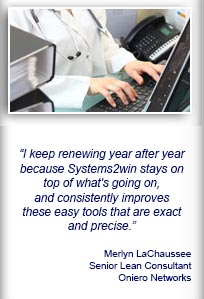Installation and Setup
Installation - Each User. Installation - Multi-user. Language Translations. Personalize Your Templates.Systems2win Training.
Quick Start Initial Training. New User Training. Training Matrix. Systems2win Leadership. Training Classes.Lean Training
Lean Training and Coaching. Lean Principles. Muda 8 Wastes. Goal - Lean Flow. Roadmap - Lean Journey. Value Stream Mapping. Standard Work. Hansei Lean Thinking. Lean Dictionary. Online Lean Training. Lean Leadership.Microsoft Office Training
Excel Training. Excel Drawings (without Visio). Excel Charts. Word Training. PDF Training. Document Storage and Naming.Support
Support.Lean Tools
8 Types of Lean Tools
1) Lean Tools for 5S Problem Identification
The primary reasons for doing 5S are:
- to reveal problems
because problems can't be solved until they are revealed
- to establish a culture
where people are encouraged to reveal problems
because any process that appears to have no problems is certain to be concealing huge problems that will never be fixed until management makes it safe for people to shine bright spotlights in previously dark corners
3 popular 5S tools are the 5S Scorecard Audit Checklist, 5S Standards Clarification worksheet, and the Red Tag Log.
2) Lean Tools for Problem Solving
Some lean leaders say that...
All lean tools are for problem solving
And they are right. There are, however, about a dozen tools that are specifically designed for solving a wide variety of common problems.
3 popular Problem Solving tools are the A3 Report, the PDCA template, and tools to lead a Kaizen Event.
3) Lean Templates for Standard Work
The 4th S... Standardize...
is by far the most difficult of the 5 S's... and the most important.
Why?
What's the point of trying to improve anything if your people just nod their heads and pretend to go along with the agreed-upon changes, and then just go right back to doing things the same way they've always done them?
3 popular Standard Work tools are the Standard Work Audit, Yamazumi operator work load balancing, and the Kanban Calculator.
4) Templates for Lean Training
As things change, you need to
train your people to do things new ways
Why?
By definition, continuous improvement is continuous.
We're not living in the 1800's any more. These days, things change often and change fast.
Without excellent systems for rapid, reliable training and re-training, there will be mistakes that affect quality, mistakes that affect safety, mistakes that affect costs...
3 popular lean templates for training are TWI Job Breakdown sheet (for 1-on-1 instructor training), the Training Matrix (for cross-training), and Work Instructions (to comply with ISO 9000, FDA, and other controlled compliance environments.
5) Process Observation and Analysis
Go to the gemba and see
Why?
The gemba is where the work actually happens.
You can't do lean process improvement by sitting in a conference room shuffling through possible outdated or inaccurate process routings and time standards.
3 popular tools for Process Observation and Analysis are the Muda Waste Observation form, the Cycle Time Observations form, and the Block Diagram.
6) Lean Tools for Heijunka Flow
Some lean leaders say that...
Flow is the most important focus of lean
Others might say that flow is one of the most important focuses of lean.
3 popular tools for lean flow are the Pitch Chart (for heijunka load leveling), Pull Queue Status (for monitoring FIFO lanes), and your suite of templates for value stream management.
7) Flowcharts and Process Engineering
Some processes simply don't fit well with traditional lean tools and methods.
Some processes need other tools
ERP systems, lengthy projects, and complex processes can get tangled up and hard to analyze.
3 popular tools for untangling complex process flows are the Swim Lane Cross Functional Flowchart, the (Swiss Army knife) simple flowchart, and Machine Balancing.
8) Lean Tools for Lean Management
Perhaps this category should have been listed first, because
Lean isn't possible without leadership
3 popular tools for Lean Management are the Values List Forced Choice Paired Comparison Matrix, SQDC Team Huddle Board headers, and the One Good Idea Before and After Storyboard.

How to choose the right lean tools
Use your Tool Selection Matrix (1ToolSelection.xlsx)
to select the right Process Improvement Tools for what you need next.

A typical lean journey starts with some combination of value stream mapping, kaizen, and/or 5S workplace organization.
It usually isn't long before you reach that all-important fourth S... to 'Standardize'
and you learn first-hand how important it is to lock in your gains with Standard Work, and Visual Work Instructions, so that people don't simply backslide into old habits, and erode so many of your hard-won gains.

Road map for a typical
Lean Transformation
Most lean journeys start with customer-facing operations, and then slowly make their way to white-collar lean office supporting functions.
Your Systems2win lean templates empower your leaders with the full suite of Process Improvement tools to not only get you started on your Lean journey — but to grow with your people as they mature through the years; continuously improving your tools, training, and systems for continuous improvement.
These Lean tools come with an entire suite of Process Improvement Tools
for lean process improvement
8 Categories of Lean Tools

Did your consultant leave you with teachable, repeatable systems?
There are valid reasons why a consultant might want newcomers to learn unfamiliar lean methods using pencil and paper, and some lean methods really can be done forever using only pencil and paper,
but many of those reasons dry up once your managers are left to mentor a large number of people using a large number of lean methods over a long period of time.
In the end, it becomes your leadership responsibility to choose the lean tools and lean training systems to affordably support and perpetuate your lean management systems and your lean culture.
Own Yours Now
Own your own professional tools
that you can take with you for the rest of your career
Download Trial Now
Get a dozen trial templates,
and another dozen free gifts
@@@ Better conversion rate
if call to action is for a specific tool, and shows the image

Try It
Try this template
along with a couple dozen more
process improvement tools
Calls to Action Botttom
Related Topics
Related Topics section WITHOUT TESTIMONIALS
Replace this paragraph with menu library item for topics related to this video
Training and Coaching
Consider Training and Coaching to support your teams to succeed

Training to get you started.
Tools you won't outgrow.
Schedule a Conference
Schedule a conference
to discuss your challenges
with an experienced lean advisor



